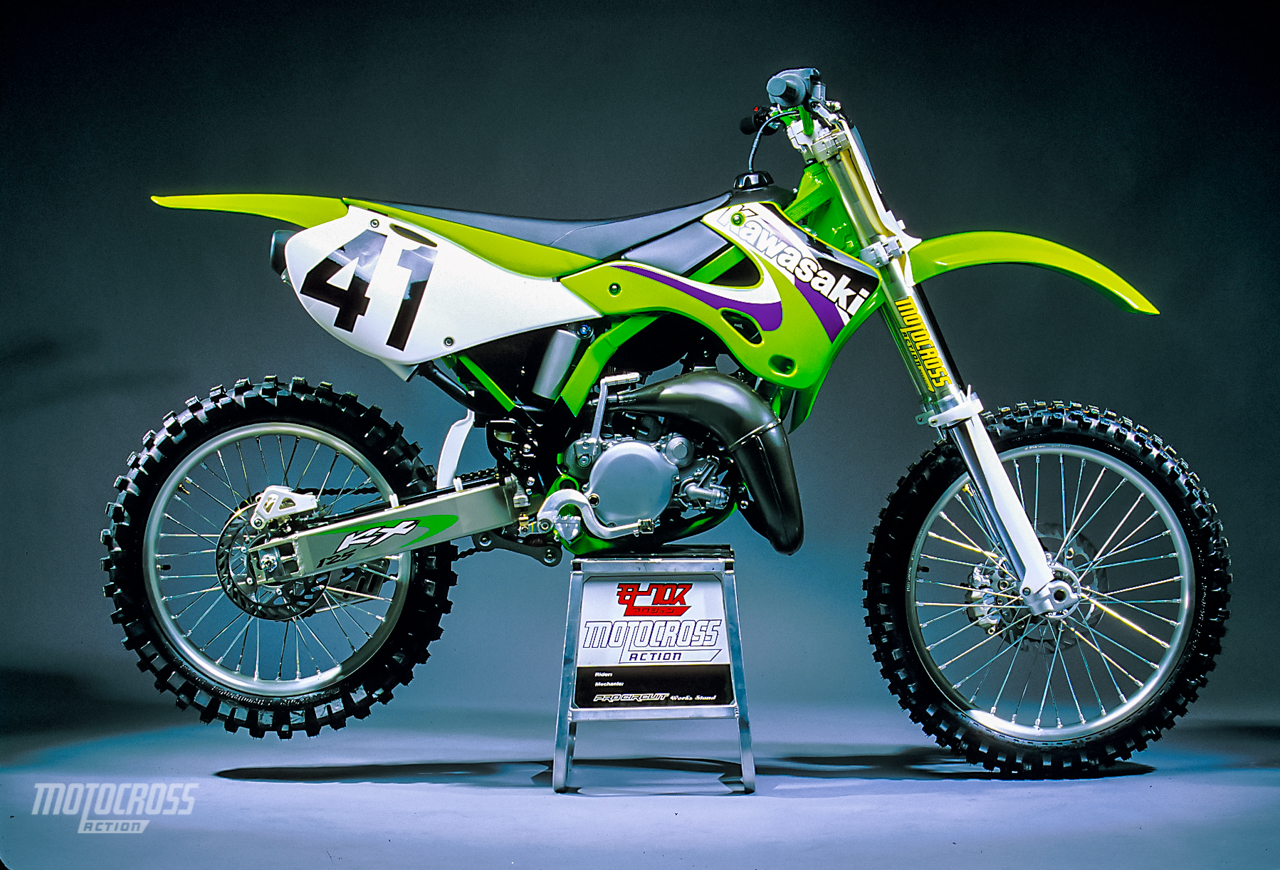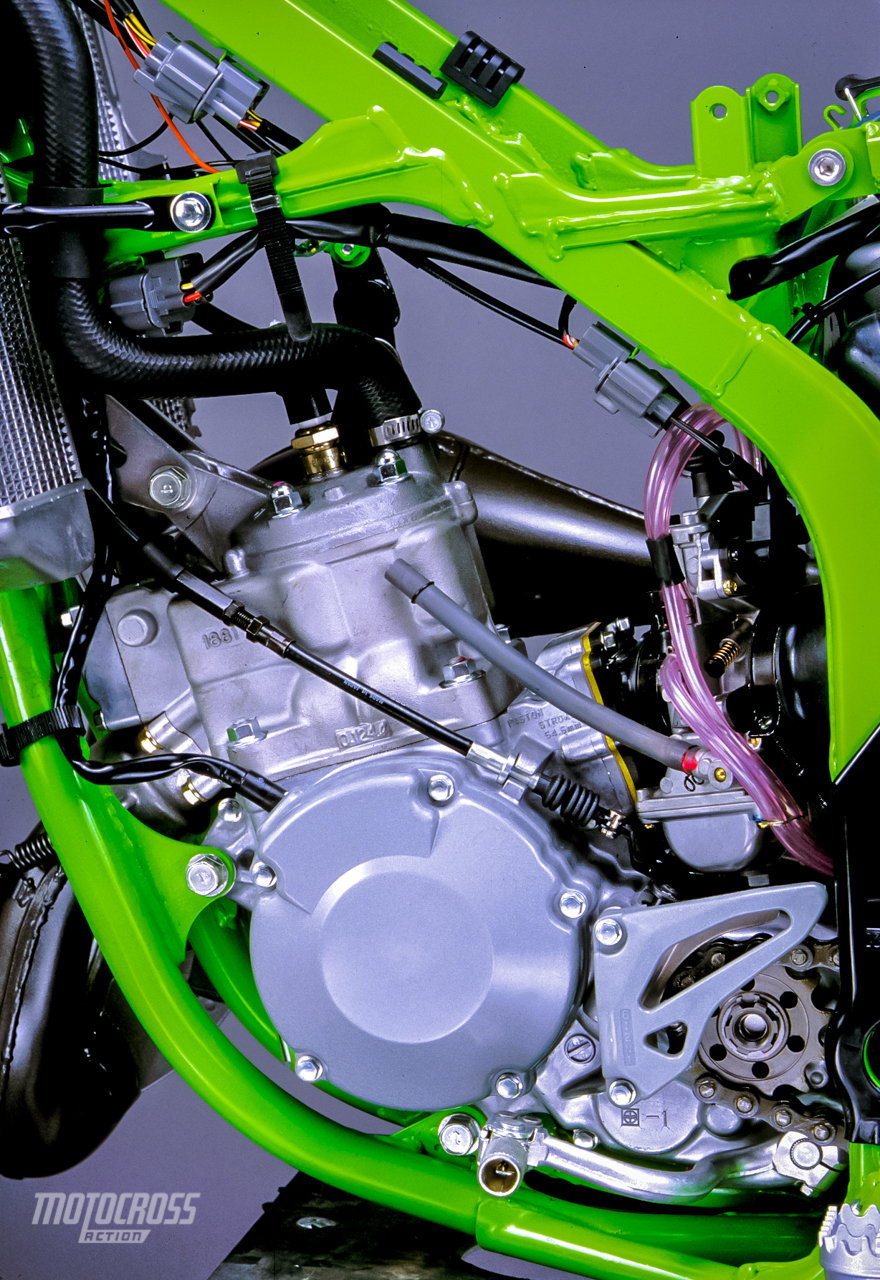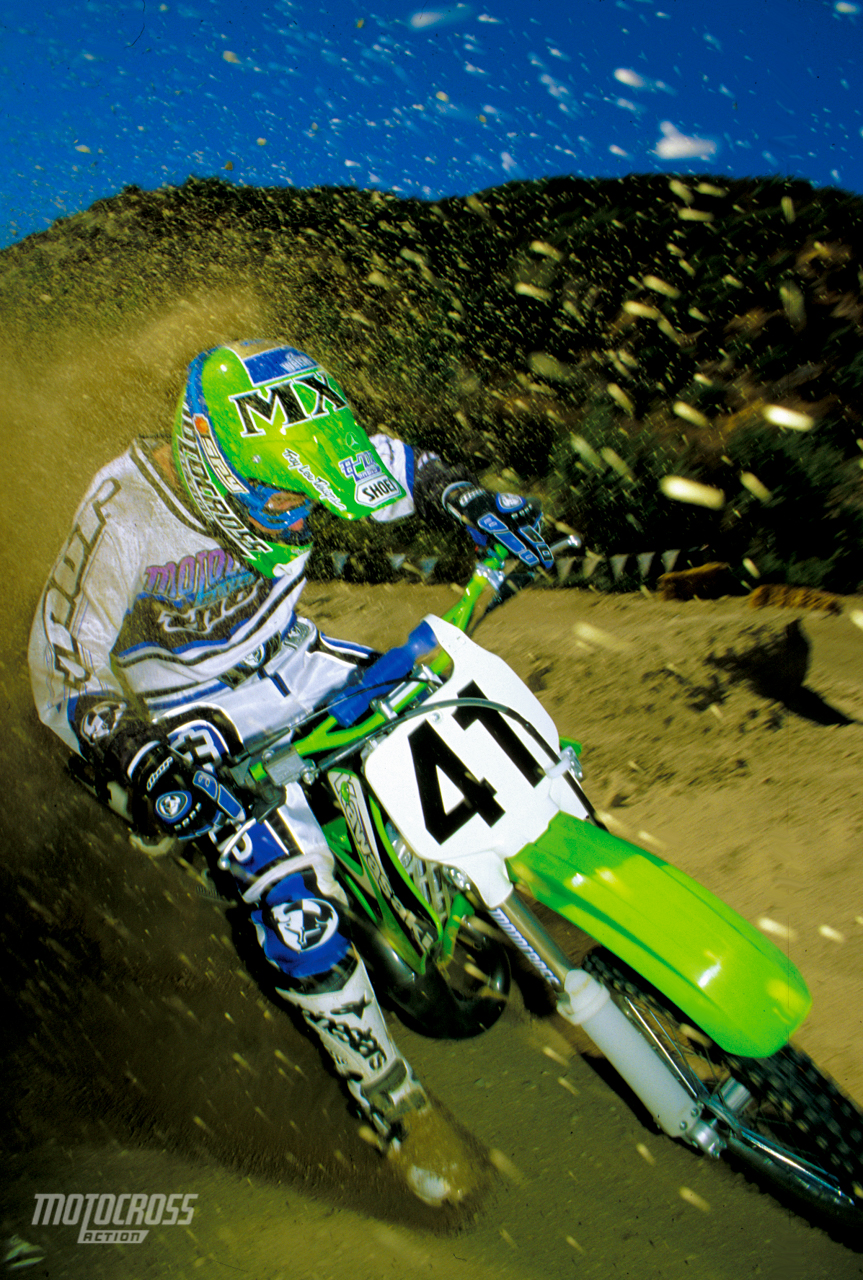ON THE RECORD: COMPLETE TEST OF THE 1999 KAWASAKI KX125
 This story is from the January 1999 issue of Motocross Action Magazine.
This story is from the January 1999 issue of Motocross Action Magazine.
Interested in a 1999 Kawasaki KX125? Don’t know anything about it? Here are a few facts:
Engine: Water-cooled, 124cc, two-stroke, reed-valved engine.
Bore and stroke: 54mm by 54mm.
Transmission: Six-speed, wet clutch.
Suspension: 12.2-inch Kayaba 46mm upside-down forks and 13-inch Kayaba shock (with 20 rebound clicks and 18 compression clicks).
Wheelbase: 56.5 inches.
Claimed weight: 191.7 pounds.
Price: $4998.
Those are the tech specs, but these are the questions that most riders want the answers to:
QUESTION ONE: IS THE ‘99 KX125 ENGINE FAST?
A: One thing is true–it’s a lot faster than the ‘98 KX125. Last year the KX125 engine was anemic. It hit in the midrange with all the power of a wet dish rag. No bottom. No top. Just a mysterious, hard-to-use and ethereal midrange. It was an embarrassment. Racing a ‘98 KX125 was like tieing your bike to an anchor on the starting line.
So is the ‘99 fast? Yes. How much faster? About two ponies faster than the ‘98 and, although power placement is relatively unchanged (no bottom and no top), the breadth of the midrange power is considerably wider. More horsepower translates into more to work with.
QUESTION TWO: IS THE ‘99 ENGINE BETTER THAN THE ‘98?
A: Didn’t you read the last paragraph. The only thing less racy than last year’s KX125 engine has Briggs and Stratton written on it.
QUESTION THREE: WHAT DID KAWASAKI DO TO THE ‘99 KX125 ENGINE?
A: We cannot reveal all the secrets of KHI (Kawasaki Heavy Industries), but we can say that Kawasaki did not have the budget to throw the KX125 engine away and start over. At least they don’t have the R&D dollars in ‘99. Although, we bet they will scrounge them up in Y2K. Why? Conglomerates don’t always respond immediately to the demands of consumers, they have other priorities. In engine development, the production life span of the casting molds plays a big part in R&D budgets. Molds have actuary tables and the KX125 engine molds will have run their course in 2000—not before.
QUESTION THREE THREE + 1: WHAT DOES ALL OF THIS MEAN?
(1) The ‘99 KX125 engine is a make-do engine. A tweak here, mod there and band-aids everywhere.
(2) Next year the KX125 will probably get an all-new engine.
That said, here is the short list of what Kawasaki’s engineers changed for ‘99.
(1) The KX125 gets revised port shapes, new inlet, changed exhaust port timing and improved KIPS valve clearance.
(2) The KX125 (and KX250) are equipped with Keihin’s latest Power Jet carb (a 36mm for the 125 and 38mm for the 250). The “shorty” carb positions the slide 12mm closer to the engine.
(3) The KX125 will get a totally new Keihin Power Jet for ‘99. The 36mm “shorty” carb is very different from last year’s: (a) The slide is positioned 12mm closer to the engine; (b) Kawasaki employed a “throttle position sensor” (labeled K-TRIC) that varies the ignition timing depending on throttle settings and engine rpm (similar to the Yamaha YZ400 throttle position sensor).
(4) The cut-outs in the side panels are no longer hand holds for picking the bike up (you have to pick it up by the rear fender), but are for air intake only. The front of the airbox is angled towards the carb for more direct airflow. Stiffer rubber is used on the air boot to keep it from flexing as the engine sucks air into the intake tract
(5) Kawasaki uses magnesium for the clutch cover instead of aluminum.
(6) Kawasaki carved, whittled, machined and hogged out as much excess metal as possible from the primary gear, kick starter idler gear, clutch drive gear and all six tranny gears.
(7) The KX125 has a new exhaust pipe and the silencer end cap stamping has had its wall thickness decreased from 1mm to 0.8mm.
QUESTION FOUR: WHAT DO THE CHANGES MEAN?
A: They mean the difference between a roach and race bike. Where the ‘98 KX125 could barely get out of its own way, the ‘99 version delivers a potent, competitive and powerful punch.
QUESTION FIVE: IS THE KX125 FASTER THAN A YZ125?
A: No. A million times no, but where the KX125 powerband works, it works well. The strength and length of the middle makes the KX125 fun to ride. This bike rewards the hard riding and, conversely, punishes the lazy. The required intensity for keeping the engine boiling is not for the weak of will. That’s why Ricky Carmichael does so well on one.
The improvement is substantial. It is significant enough to earn the KX125 the “Most Improved 125 of ‘99” award.
QUESTION SIX: WHAT ABOUT THE JETTING?
A: We had a minor problem with the engine being rich in the middle (which couldn’t be fixed with something as simple, inexpensive and understandable as a clip position). To lean out the middle, we swapped the stock N7PW needle for a N7NW. Here is what we ran in our bike for SoCal’s sea level tracks:
Mainjet: 158
Pilot jet: 45
Power Jet: 52
Needle: N7NW (N7PW stock)
Air screw: 1-1/2 turns
Clip: groove number 3
Note: The KX125’s new carb is very sensitive to air screw settings. We could make it rich or lean in less than a half turn of the air screw.
QUESTION SEVEN: HOW GOOD IS THE GEARING?
A: Do yourself a favor and get your dealer to throw in a 49-tooth rear sprocket. Lower gearing helps the KX125 immensely.
QUESTION EIGHT: WHAT ABOUT THE REAR SUSPENSION?
A: Awesome! The ‘99 KX125 rear suspension is the best on the track. Roll it out of the showroom, set the sag at 95mm and live happily ever after.
WHAT WAS OUR BEST SETTING?
Spring rate: 4.6/4.8/5.0 kg/mm
Race sag: 97mm
Hi compression: 2-1/2 turns out
Lo compression: 10 clicks out
Rebound: 12 clicks out
QUESTION NINE: HOW GOOD ARE THE NEW FORKS?
A: Albeit with lighter damping and spring rates, the ‘99 KX125 forks are the same Kayaba units that come on the KX250. We didn’t like the KX250 forks very much. They had three problems: (1) The progressive rate springs are too soft on initial stroke and allow the bike to hang down under a load; (2) The oil height is not sufficient to stop harsh bottoming over big jumps; (3) Midstroke compression and rebound contribute to a porpoise-effect when landing from jumps.
The KX125 forks, because of the lighter weight of the machine, do not exhibit the bad traits of the KX250–or at least not to the same degree. We did swap the stock 0.39/0.41 progressive springs for the next stiffest 0.40/0.42 progressive springs (but only because Kawasaki does not offer a 0.42 straight rate spring). The stiffer springs helped maintain the proper attitude when attacking rough sections of the track (and were a big help in absorbing G-outs). Still, the forks have a tendency to bottom out with a clank. Across the board, the KX125 forks received a “good” rating.
QUESTION TEN: WHAT ARE THE BEST FORK SETTINGS?
A: What was our best setting? For hardcore racing we recommend this set-up:
Spring rate: 0.40/0.42 kg/mm (0.39/0.41 stock)
Oil height: 97mm (107mm stock)
Compression: 10 clicks out
Rebound: 11 clicks out
Fork leg height: 3mm above top of stanchion
Notes: The simplest way to get the stiffer 0.40/0.42 progressive spring is from a KX250 rider who replaced it with a stiffer 0.43 or 0.44 straight rate spring. The 0.40/0.42 comes stock on the ‘99 KX250. We raised the oil height by 10mm to aid the fork’s resistance to bottoming over big jumps.
QUESTION 11: HOW DOES IT HANDLE?
A: It’s rare that a chassis finds universal acceptance among the test riders, but there is something about the KX125 that appeals to the quirks of a variety of people. What’s so odd about that? (1) The KX125 is the least 125-ish of all the tiddlers. The frame is big, wide and girthy. (2) The turning radius is not as razor sharp as an RM125’s–it takes its time. However, since the wheelbase is 30mm shorter than the KX250’s it’s not a slow handler (just relaxed). (3) When sitting astride the KX125 you could swear you were aboard a KX250. It has the same ergos, but the numbers are not identical. The KX125 steering head is moved back 15mm, while the swingarm is shortened 10mm. This makes the little KX more agile than its big brother–although the sensation of roominess is hard to erase.
Do we think it is a great handling 125? No. But given their druthers, this is the 125 chassis that most test riders choose as their favorite. The paradoxes are many: Not the quickest turning; not the most stable; not the lightest feeling; not the most diminutive; still in all, the favorite.
QUESTION 12: WHAT DID WE HATE?
The hate list:
(1) Decals: The decals on the swingarm blew off at the car wash (on the soap cycle).
(2) Tank: The black gas tank makes it hard to see the fuel level (although, Kawasaki did put a white anti-slosh tube into the opening to reflect more light into the cavity).
(3) Brakes: The front brake is mushy. Braking power is minimal when compared to other brands (Euro brands included).
(4) Bars: We won’t ride with the stock handlebars (after a pair bent in a rider’s hands when landing from a jump).
(5) Jetting: The stock jetting is just far enough off for inexperienced riders to ignore (which is the worst kind of jetting mistake).
(6) Saddle: Kawasaki’s seats were never terrific, but normally they were too soft. The ‘99 saddle is thin in the back (a la Yamaha) and too steep in the front. The seat brackets are riveted on and they have the irritating habit of snapping off. Watch them closely.
(7) Tranny: Shifting is notchy. Missed upshifts are common. Try to shift before maxing out the revs.
(8) Number plates: Full coverage side panels replace last year’s airbox insert-style side panels. Some test riders thought that they added to the width of the KX’s mid-section.
(9) Bar clamps: We mounted a KX250 top triple clamp to our KX125. The KX125 comes with solid bar mounts, while the KX250 bar clamps are rubber mounted and reversible. We felt the need to move the bars forward in the clamps.
QUESTION 13: WHAT DID WE LIKE?
The like list:
(1) Pipe: We love the coating Kawasaki puts on its exhaust pipe. It’s durable, non-rusting and trick looking.
(2) Air filter: The air filter locating system uses two prongs. We like this, but always reach in the airbox and make sure the bottom prong is in the hole.
(3) Grips: The new half-waffle grips are on the fat side for the typical 125 rider. However, they are terrific feeling (thanks to very low-profile waffles).
(4) Frame: The subframe is square section aluminum (instead of round steel tubing).
(5) Spokes: Aluminum spoke nipples replace last year’s steel nipples.
(6) Frame guards: Plastic frame guards (a la KTM) have been added to keep the frame spars from scratching.
(7) Brackets: The radiators are supported by small braces to keep them from bending backwards in a crash.
(8) Axle: The front axle clamp is a Honda-style two pinch bolt design.
(9) Shock: The rear shock offers high- and low-speed compression damping (a la Honda).
(10) Sneakers: The KX125 comes with a Dunlop K490 (front) and K739 (rear).
(11) Linkage: The rear shock linkage gets needle bearings to lessen stiction and binding.
(12) Rims: The U-rims are very trick looking, but the jury is still out on durability.
QUESTION 14: WHAT DO WE REALLY THINK?
Engine: The ‘99 powerband is very one-dimensional (midrange only), but it’s so good at what it does that most MXA test riders preferred the KX125 style of power over the Suzuki, Husqvarna and Honda midrange engines. Yamaha and KTM have different powerbands altogether.
Handling: The small KX feels just like its big brother. We had our doubts that a 125 with 250 ambience would be a pleasant experience, but it was. It doesn’t feel like a toy. It goes where you aim it and seems to absorb feedback better than your typical tiddler chassis. The KX125 has a much shorter wheelbase than the KX250, which eliminates the big KX’s reluctance to turn tight berms. Not every rider will fall in love with the big bike feel of the KX125, but every MXA test rider did.
Suspension: The best all-around suspension in the 125 class. The forks are less effective than the rear shock, but the combo adds up to a race-ready bike.
Overall rating: Last year, when a test rider was assigned to race the KX125, he acted like he was being given a blindfold, cigarette and asked to stand over by a wall. For ‘99, the pall has lifted. It’s a great bike with a good engine.










Comments are closed.